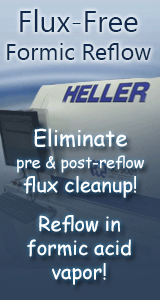Mr. Wizard is not currently available. You get the wizzer. Maybe your dream date will show later.
Get your own lab tests done. Show your potential customer that your boards are clean. That�s the issue. The issue is not how you go about cleaning them.
Saponifiers are very useful, depending on the type of flux. They�re designed for rosins and resins. The two primary methods, nowadays, for cleaning rosins and resins are: * Semiaqueous. A cleaning process using a solvent followed by a hot water rinse and drying. * Saponifiers. Alkaline chemicals, added to water, that convert rosin/resin flux residues in the water to soluble soaps.
Assuming you�re using an aqueous flux, a saponifier won�t do dip about removing flux res. Even if you wanted to use a saponifier with your aqueous, is your washer BIG enough [have enough sections / isolation] to run a saponifier?
Responding to the conflicting theories: ADD THE SAPONIFIER, IT�S A �NEW & IMPROVED� DETERGENT: It�s not a detergent. It�s a badass base [alkali] that when dissolved in water produces hydrogen ions. The pH of a saponifier must be at least 10.5 to get the hydrogen peroxide in the water going. [Watch your safety compliance manager snap to attention, when you tell him that!!!] SAPONIFIER IS A PROTECTIVE COATING: If the sections of the washer that come after the saponifier section [i.e., Wash 1, Wash 2, Rinse, DI Rinse, etc] are not operating, there will be a saponifier coating on the product. If left on the product, a coating of saponifier will be more disastrous than leaving flux on the product.
If I had to guess why a PGA socket was growing fuzz after aqueous wash, I�d guess that it wasn�t dried properly. If you fill a PGA socket with water and then add the component, it could take a looooong time to dry-out, all the while presenting the perfect medium for corrosion and other crunchy things. Even if you don�t stuff the socket, it�ll still take a looong time to dry.
An alternate hypothesis takes the �poor drying� spiel [above] a step further and speculates the socket was never properly cleaned, still retaining flux / wash res. It would be interesting to review the lab test results to determine what the source or ID of the residue on the sockets.
I�d say the solution is to either: * Loose the socket. [I know. I know. �The socket is important to our customers� ability to maintain the board." Sure. Customers don�t replace processors, they replace memory. Wuttevah.] * Selective solder the socket in NC, as a third process. * Dry the socket after cleaning. * "Seal" the socket with a low-res tape to prevent solder / cleaning materials from entering the socket. * Determine if there is a more appropriate socket.
For more on saponifiers: contact Frank Cala at Church & Dwight [calafr@churchdwight.com], he�s written a [THE???] book [�Aqueous Cleaning Technology For Electronic Assemblies� F. R. Cala & A. E. Winston; Electrochemical Publications; ISBN 0 901150 31 2] on saponifiers, a SMTA member, and very smart.
Always remember: Give the customer what he asks for, so long as he�s not too retarded.
reply »
![]() I am looking to learn of possible causes and solutions for t...
- Oct 05, 2001
by
Michael Parker
I am looking to learn of possible causes and solutions for t...
- Oct 05, 2001
by
Michael Parker
![]()
![]()
![]() Mr. Wizard is not currently available. You get the wizzer. ...
- Oct 06, 2001
by
davef
Mr. Wizard is not currently available. You get the wizzer. ...
- Oct 06, 2001
by
davef
![]()
![]()
![]() Dream date? Would that be the St. Pauli girl? I like 'em bui...
- Oct 08, 2001
by
Michael Parker
Dream date? Would that be the St. Pauli girl? I like 'em bui...
- Oct 08, 2001
by
Michael Parker
![]()
![]()
![]() No wizard here just a troll....Sorry I can not spout a Fount...
- Oct 08, 2001
by
CAL
No wizard here just a troll....Sorry I can not spout a Fount...
- Oct 08, 2001
by
CAL
![]()
![]()
![]() Cal - even trolls were smart enough to outwit most back in t...
- Oct 09, 2001
by
Michael Parker
Cal - even trolls were smart enough to outwit most back in t...
- Oct 09, 2001
by
Michael Parker
![]()
![]()
![]() I just realized my last posting has some incorrect reference...
- Oct 09, 2001
by
Michael Parker
I just realized my last posting has some incorrect reference...
- Oct 09, 2001
by
Michael Parker
![]()







